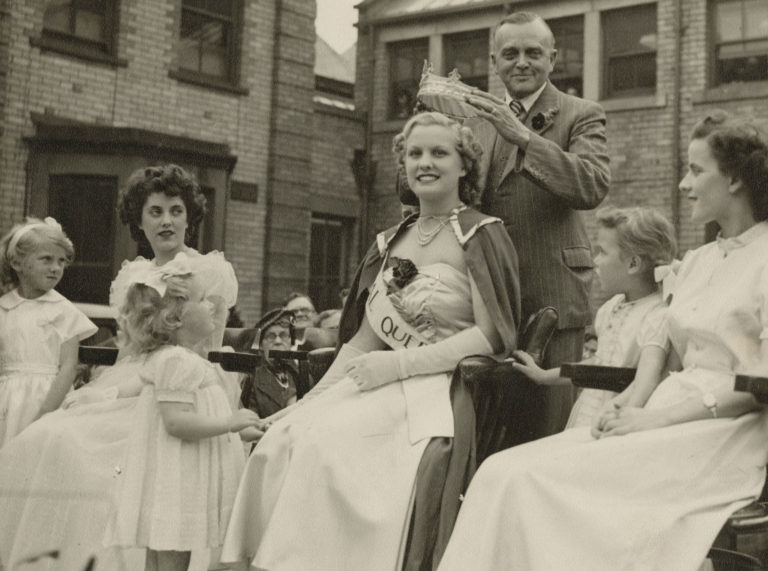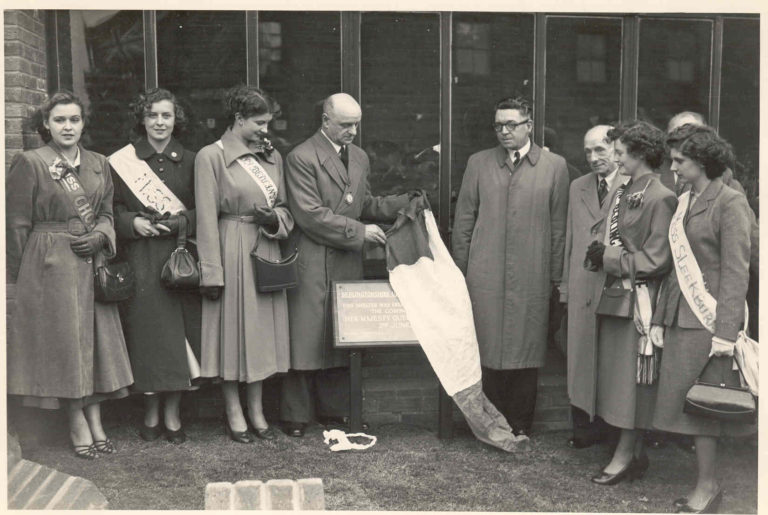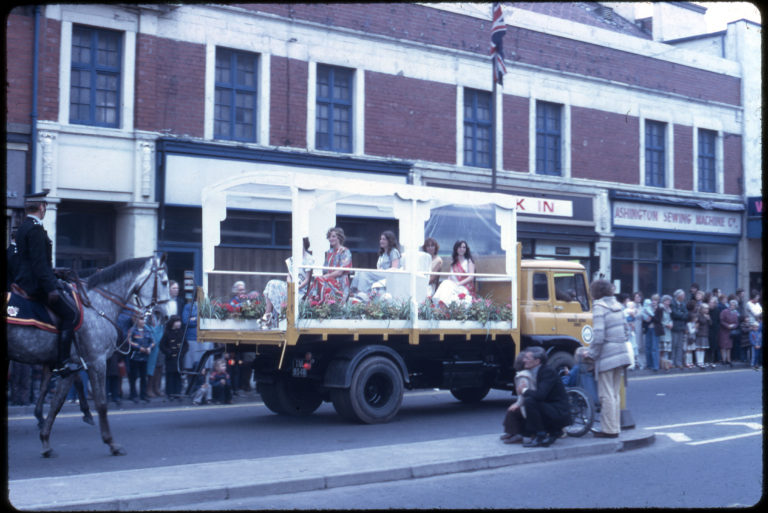Photographs of Coal Queens, 1952, 1953, 1979
Reference: NRO 07357/37, NRO 08523/14, NRO 06978/3/37
Suggested age groups: KS1, KS2, KS3, KS4, Lifelong Learners
Subject areas: History, Literacy, Art, Design Technology, Textiles
CONTEXT
NRO 07375/37 Black and white photograph of the crowning of Mrs Sally Smith, Coal Queen, Ashington Colliery Pit Yard, Northumberland, 1952. The Coal Queen is crowned by Mr Donald Hindson, M.C., National Coal Board Area General Manager, No.3 Area.
NRO 08523/14 Black and white photograph of the Miss Bedlingtonshire Beauty Queen Gillian McNair and other beauty queens at an unveiling the ‘Coronation Shelter’, 1 June 1953.
NRO 06978/3/37 Photograph showing ‘Coal Queen’ float from Northumberland Miners Picnic held at Ashington, 9 June 1979.
In the first half of the twentieth-century, various industries introduced beauty competitions for young women. “Industry Queens” represented textile manufacture, railways, and coal mines. Industry Queens were similar to the older tradition of the May Queen or Carnival Queen where a young woman would be chosen by her community to be “queen” for their celebrations. Like May Queens, Industry Queens would often be crowned by a person of importance, would wear elaborate or new dresses and take part in a parade.
Industry Queens would also be used by the company or organisation that they represented for publicity. They would have their photographs taken for advertisements and appear at public events.
The Coal Queen pageant in Northumberland ran from the 1930s until the 1980s within mining communities. Coal Queens could be the wife, sister or daughter of pit workers and would be crowned each year at local miners’ picnics or carnivals. The competition added a touch of glamour to the heavy, dirty, and gritty nature of their work.
Local queens would be selected to represent a colliery or colliery town. Local queens would be entered into the regional competition to become Coal Queen for Northumberland, who would be crowned at the Miners’ Picnic. Regional queens, like the Northumberland queen, would then compete for a national title with other young women from across the country. Prizes of the national competition included exotic trips at a time when few people went abroad on holiday.
ACTIVITIES
ACTIVITY 1
Background
In the first half of the twentieth-century, various industries introduced beauty competitions for young women. “Industry Queens” represented textile manufacture, railways, and coal mines. Industry Queens were similar to the older tradition of the May Queen or Carnival Queen where a young woman would be chosen by her community to be “queen” for their celebrations. Industry Queens would often be crowned by a person of importance, would wear elaborate or new dresses and take part in a parade.
The Coal Queen pageant in Northumberland ran from the 1930s until the 1980s within mining communities. Coal Queens could be the wife, sister or daughter of pit workers and would be crowned each year at local miners’ picnics or carnivals. The competition added a touch of glamour to the heavy, dirty, and gritty nature of their work.
SEE
See: What is being shown in the photographs?
See: What is an Industry Queen?
See: What is a Coal Queen?
See: Who could be a Coal Queen?
See: How was a Coal Queen chosen?
See: When did Coal Queen competitions take place in Northumberland?
THINK
Think: What types of outfits would a Coal Queen have worn?
Think: What would parade floats have looked like?
Think: How were Coal Queens used as publicity for collieries?
Think: How were women involved in the mining community?
Think: Why did Coal Queen pageants stop
Think: What would a pageant have been like?
Think: Do pageants take place today?
DO
Do: Read the interviews with Coal Queens. Make notes of any points that interest you or you would like to learn more about.
Do: Watch the video interviews with Northumberland Coal Queens. Make notes of any points that interest you or you would like to learn more about.
Do: Based on what you have learned from the interviews, write an article about the experiences of Coal Queens.
Do: Create a publicity advertisement for a colliery using an image of a Coal Queen.
Do: Design an outfit for a Coal Queen.
Do: Create a felt puppet Coal Queen.
Do: Hold a pageant for the felt puppet Coal Queens.
Do: Design a parade float for a Coal Queen.
Do: Make a small version of a Coal Queen parade float based on your design.
Do: Look up the industry your local area is known for. Design an industry queen and parade float for your local industry.
Resources
OTHER ONLINE RESOURCES
Coal Queens
Vintage Everyday website, page about Coal Queens, including photographs from Northumberland Archives https://www.vintag.es/2018/11/coal-queens.html
Nottinghamshire Mining Museum website, blog about Coal Queens: https://www.nottsminingmuseum.org.uk/women-coal-queens/
BBC Tyne news website, article about Coal Queens (2011): http://news.bbc.co.uk/local/tyne/hi/front_page/newsid_9364000/9364357.stm
University of Huddersfield website, transcript of oral history interview with Margaret Lister, Yorkshire Coal Queen in 1972: http://eprints.hud.ac.uk/id/eprint/16726/1/Paul_Ward_Coal_Queen_edited_transcript.pdf
Newspaper articles
Daily Mail newspaper article, includes photographs from Northumberland Archives and interviews with former Coal Queens: https://www.dailymail.co.uk/femail/article-2710837/The-Coal-Queens-Retro-images-1960s-beauty-pageant-showcase-glamorous-coal-mining.html
Guardian newspaper article about revival of Coal Queen competition in 2008: https://www.theguardian.com/uk/2008/feb/22/britishidentity.gender
Chronicle newspaper website, article about Coal Queens for National Coal Mining Museum exhibition, including interview with Northumberland Coal Queens: https://www.chroniclelive.co.uk/news/north-east-news/coal-queen-pin-ups-recalled-new-1415273
Videos
Leeds Museums Facebook page, short video (38 seconds), interview with Deborah Bromley, Coal Queen of Ellington, Northumberland: https://fb.watch/cES6GcqRCj/
YouTube website, ITV news report about Woodhorn exhibition (2011). Includes interview with Marie Danes, Bates (Blyth) Pit Coal Queen (3 minutes): https://www.youtube.com/watch?v=PpUA4kxsAew




